Evaluation of Subseasonal Precipitation Simulations for the Sao Francisco River Basin, Brazil
Abstract
:1. Introduction
2. Materials and Methods
2.1. Study Area
2.2. Eta Model
2.3. Observational Data
3. Results and Discussion
3.1. Precipitation Pattern
3.2. Interannual Variability
3.3. Intramonthly Variability
3.4. Simulation Accuracy
4. Conclusions
Author Contributions
Funding
Data Availability Statement
Conflicts of Interest
References
- Filho, J.G.G.; Formiga, K.T.; Duarte, R.X.; Sugai, M.R. Análise da Cheia de 2004 na Bacia do Rio São Francisco. In Proceedings of the Simpósio Brasileiro de Desastres Naturais, Florianopolis, Brazil, 27–30 September 2004. [Google Scholar]
- Rodwell, M.J.; Doblas-Reyes, F.J. Medium-range, monthly, and seasonal prediction for Europe and the use of forecast information. J. Clim. 2006, 19, 6025–6046. [Google Scholar] [CrossRef]
- Vitart, F.; Ardilouze, C.; Bonet, A.; Brookshaw, A.; Chen, M.; Codorean, C.; Déqué, M.; Ferranti, L.; Fucile, E.; Fuentes, M.; et al. The subseasonal to seasonal (S2S) prediction project database. Bull. Am. Meteorol. Soc. 2017, 98, 163–173. [Google Scholar] [CrossRef]
- Alvares, C.A.; Stape, J.L.; Sentelhas, P.C.; Gonçalves, J.L.M.; Sparovek, G. Köppen’s climate classification map for Brazil. Meteorol. Z. 2013, 22, 711–728. [Google Scholar] [CrossRef] [PubMed]
- Mesinger, F. A blocking technique for representation of mountains in atmospsheric models. Riv. Meteor. Aeronaut. 1984, 44, 195–202. [Google Scholar]
- Mesinger, F.; Chou, S.; Gomes, J.; Jovic, D.; Lazic, L.; Lyra, A.; Ristic, I. An Upgraded Version of the Eta Model; European Geosciences Union (EGU) General Assembly: Munich, Germany, 2011; p. 2011. [Google Scholar]
- Black, T.L. The new NMC mesoscale Eta model: Description and forecast examples. Weather. Forecast. 1994, 9, 265–278. [Google Scholar] [CrossRef]
- Mesinger, F.; Janjić, Z.I.; Ničković, S.; Gavrilov, D.; Deaven, D.G. The step-mountain coordinate: Model description and performance for cases of Alpine lee cyclogenesis and for a case of an Appalachian redevelopment. Mon. Weather. Rev. 1988, 116, 1493–1518. [Google Scholar] [CrossRef]
- Chou, S.C.; Ferreira, N.C.R.; Rocha, M.L.; Gomes, J.L.; Dereczynski, C.; Sueiro, G. From subseasonal to seasonal forecasts over South America using the Eta Model. In Numerical Weather and Climate Modeling: Beginning, Now, and Vision of the Future; Cambridge University Press: Cambridge, UK, 2018. [Google Scholar]
- Seluchi, M.E.; Chou, S.C. Evaluation of two Eta Model versions for weather forecast over South America. Geofísica Int. 2001, 40, 219–237. [Google Scholar] [CrossRef]
- Seluchi, M.E.; Chou, S.C. Synoptic patterns associated with landslide events in the Serra do Mar, Brazil. Theor. Appl. Clim. 2009, 98, 67–77. [Google Scholar] [CrossRef]
- Seluchi, M.E.; Chou, S.C.; Gramani, M. A case study of a winter heavy rainfall event over the Serra do Mar in Brazil. Geofísica Int. 2011, 50, 41–56. [Google Scholar] [CrossRef]
- Siqueira, V.A.; Collischonn, W.; Fan, F.M.; Chou, S.C. Ensemble flood forecasting based on operational forecasts of the regional Eta EPS in the Taquari-Antas basin. Rev. Bras. Recur. Hídricos 2016, 21, 587–602. [Google Scholar] [CrossRef]
- Pilotto, I.L.; Chou, S.C.; Nobre, P. Seasonal climate hindcasts with Eta model nested in CPTEC coupled ocean–atmosphere general circulation model. Theor. Appl. Clim. 2012, 110, 437–456. [Google Scholar] [CrossRef]
- Bustamante, J.F.; Gomes, J.L.; Chou, S.C. 5-Years Eta Model Seasonal Forecast Climatology over South America; CSHMO: Foz do Iguaçu, Brazil, 2006. [Google Scholar]
- Weber, T.M.; Dereczynski, C.P.; dos Santos Souza, R.H.; Chou, S.C.; Bustamante, J.F.; de Paiva Neto, A.C. Investigação da Previsibilidade Sazonal da Precipitação na Região do Alto São Francisco em Minas Gerais. Anuário Inst. Geociências 2016, 38, 24–36. [Google Scholar] [CrossRef]
- Resende, N.; Chou, S.C. Influência das condições do solo na climatologia da previsão sazonal do modelo ETA. Rev. Bras. Climatol. 2015, 15. [Google Scholar] [CrossRef]
- Ferreira, N.C.R.; Chou, S.C. Influência do tipo de textura e umidade inicial do solo sobre a simulação da precipitação sazonal e de extremos de precipitação no sudeste do Brasil. Anuário Inst. Geociências 2018, 41, 680–689. [Google Scholar] [CrossRef]
- Bombardi, R.J.; Moron, V.; Goodnight, J.S. Detection, variability, and predictability of monsoon onset and withdrawal dates: A review. Int. J. Clim. 2019, 40, 641–667. [Google Scholar] [CrossRef]
- Mishra, A.K.; Singh, V.P. review of drought concepts. J. Hydrol. 2010, 391, 202–216. [Google Scholar] [CrossRef]
- ANA. PAE: Programa de Ações Estratégicas Para O Gerenciamento Integrado da Bacia do Rio São Francisco e da Sua Zona Costeira; GEF São Francisco: Relatório Final, Brasília, 2004. [Google Scholar]
- Chiew, F.H. Estimation of rainfall elasticity of streamflow in Australia. Hydrol. Sci. J. 2006, 51, 613–625. [Google Scholar] [CrossRef]
- Janjic, Z.I. Forward-backward scheme modified to prevent two-grid-interval noise and its application in sigma coordinate models. Contrib. Atmos. Phys. 1979, 52, 69–84. [Google Scholar]
- Janjić, Z.I. Nonlinear advection schemes and energy cascade on semi-staggered grids. Mon. Weather. Rev. 1984, 112, 1234–1245. [Google Scholar] [CrossRef]
- Betts, A.K.; Miller, M.J. A new convective adjustment scheme. Part II: Single column tests using GATE wave, BOMEX, ATEX and arctic air-mass data sets. Q. J. R. Meteorol. Soc. 1986, 112, 693–709. [Google Scholar]
- Zhao, Q.; Carr, F.H. A prognostic cloud scheme for operational NWP models. Mon. Weather. Rev. 1997, 125, 1931–1953. [Google Scholar] [CrossRef]
- Schwarzkopf, M.D.; Fels, S.B. The simplified exchange method revisited: An accurate, rapid method for computation of infrared cooling rates and fluxes. J. Geophys. Res. Atmos. 1991, 96, 9075–9096. [Google Scholar] [CrossRef]
- Lacis, A.A.; Hansen, J. A parameterization for the absorption of solar radiation in the earth’s atmosphere. J. Atmospheric Sci. 1974, 31, 118–133. [Google Scholar] [CrossRef]
- Paulson, C.A. The mathematical representation of wind speed and temperature profiles in the unstable atmospheric surface layer. J. Appl. Meteorol. 1970, 9, 857–861. [Google Scholar] [CrossRef]
- Ek, M.B.; Mitchell, K.E.; Lin, Y.; Rogers, E.; Grunmann, P.; Koren, V.; Gayno, G.; Tarpley, J.D. Implementation of Noah land surface model advances in the National Centers for Environmental Prediction operational mesoscale Eta model. J. Geophys. Res. Atmos. 2003, 108. [Google Scholar] [CrossRef]
- Saha, S.; Moorthi, S.; Pan, H.L.; Wu, X.; Wang, J.; Nadiga, S.; Tripp, P.; Kistler, R.; Woollen, J.; Behringer, D.; et al. The NCEP climate forecast system reanalysis. Bull. Am. Meteorol. Soc. 2010, 91, 1015–1058. [Google Scholar] [CrossRef]
- Lima, W.F.; Vendrasco, E.P.; Vila, D. Desempenho dos Modelos de Estimativa de Precipitação Por Satélite No Inverno/Verão no América do Sul. 2012. Available online: https://www.researchgate.net/profile/Wagner-Lima-6/publication/281824477_Desempenho_dos_Modelos_de_Estimativa_de_Precipitacao_por_Satelite_no_InvernoVerao_na_America_do_Sul/links/55f9a47308aeafc8ac26ef38/Desempenho-dos-Modelos-de-Estimativa-de-Precipitaca (accessed on 10 August 2023).
- Laverde-Barajas, M.; Perez, G.C.; Filho, J.D.; Solomatine, D. Assessing the performance of near real-time rainfall products to represent spatiotemporal characteristics of extreme events: Case study of a subtropical catchment in south-eastern Brazil. Int. J. Remote. Sens. 2018, 39, 7568–7586. [Google Scholar] [CrossRef]
- Joyce, R.J.; Janowiak, J.E.; Arkin, P.A.; Xie, P. CMORPH: A method that produces global precipitation estimates from passive microwave and infrared data at high spatial and temporal resolution. J. Hydrometeorol. 2004, 5, 487–503. [Google Scholar] [CrossRef]
- Nice, K.A.; Coutts, A.M.; Tapper, N.J. evelopment of the VTUF-3D v1. 0 urban micro-climate model to support assessment of urban vegetation influences on human thermal comfort. Urban Clim. 2018, 24, 1052–1076. [Google Scholar] [CrossRef]
- Lorenz, C.-L.; Packianather, M.; Spaeth, A.B.; De Souza, C.B. Artificial Neural Network-Based Modelling for Daylight Evaluations; SimAUD: Delft, The Netherlands, 2018. [Google Scholar]
- Shu, C.; Gaur, A.; Wang, L.; Bartko, M.; Laouadi, A.; Ji, L.; Lacasse, M. Added value of convection permitting climate modelling in urban overheating assessments. Build. Environ. 2022, 207, 108–415. [Google Scholar] [CrossRef]
- Chakraborty, D.; Dobor, L.; Zolles, A.; Hlásny, T.; Schueler, S. High-resolution gridded climate data for Europe based on bias-corrected EURO-CORDEX: The ECLIPS dataset. Geosci. Data J. 2021, 8, 121–131. [Google Scholar] [CrossRef]
- Resende, N.C.; Miranda, J.H.; Cooke, R.; Chu, M.L.; Chou, S.C. Impacts of regional climate change on the runoff and root water uptake in corn crops in Parana, Brazil. Agric. Water Manag. 2019, 221, 556–565. [Google Scholar] [CrossRef]
- Marengo, J.A.; Cunha, A.P.; Alves, L.M. A seca de 2012-15 no semiárido do Nordeste do Brasil no contexto histórico. Rev. Climanálise 2016, 3, 49–54. [Google Scholar]
- Marengo, J.A.; Alves, L.M. Crise hídrica em São Paulo em 2014: Seca e desmatamento. GEOUSP Espaço Tempo (Online) 2015, 19, 485–494. [Google Scholar] [CrossRef]
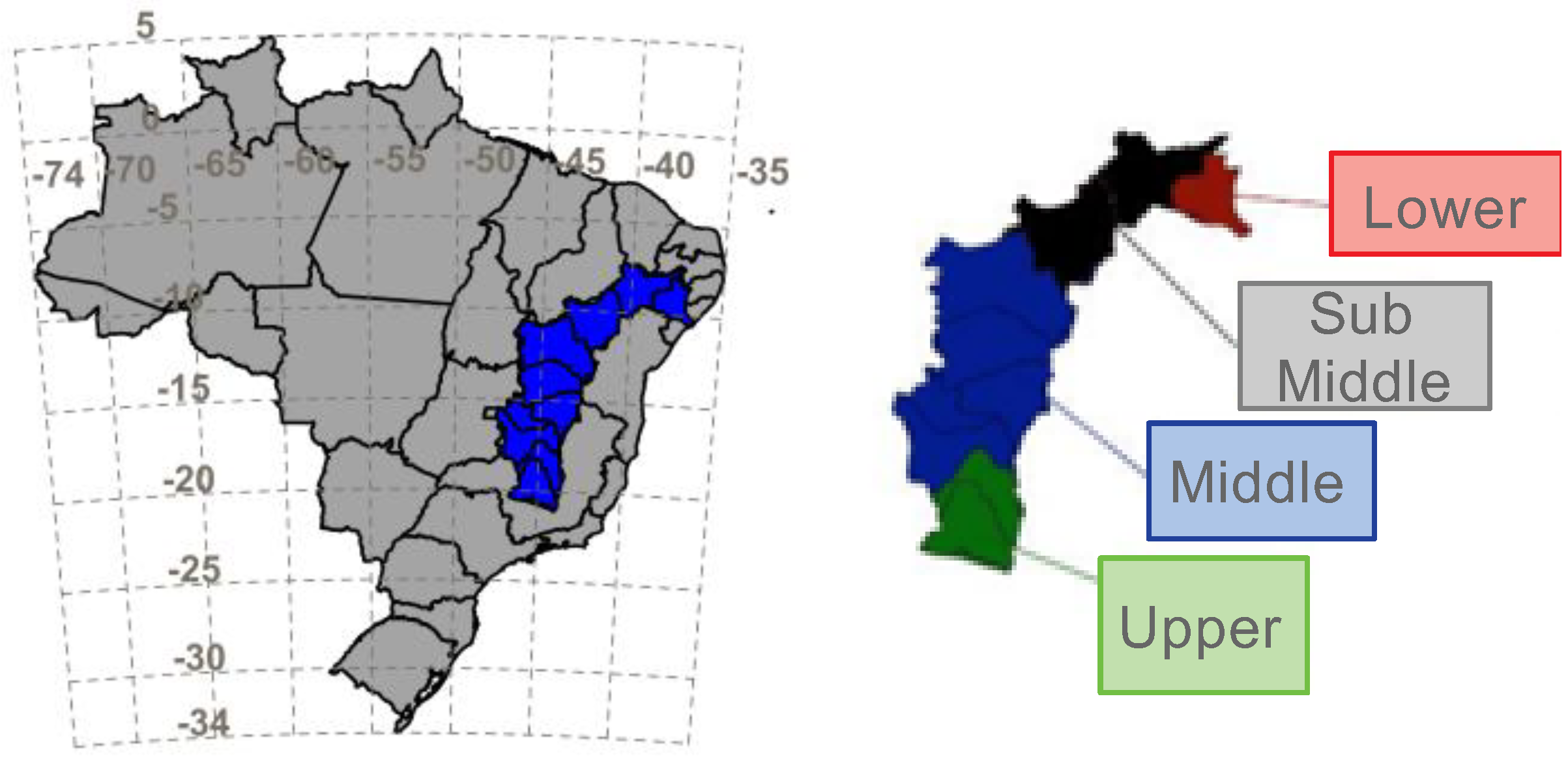
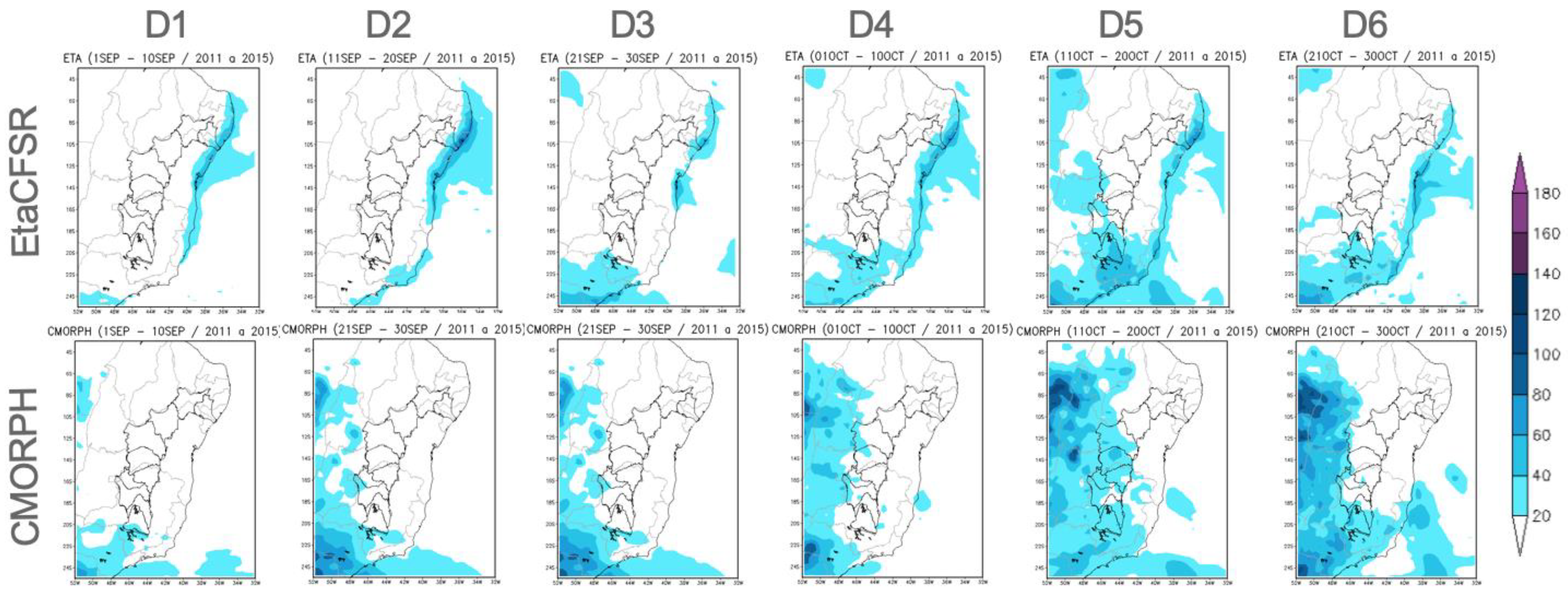
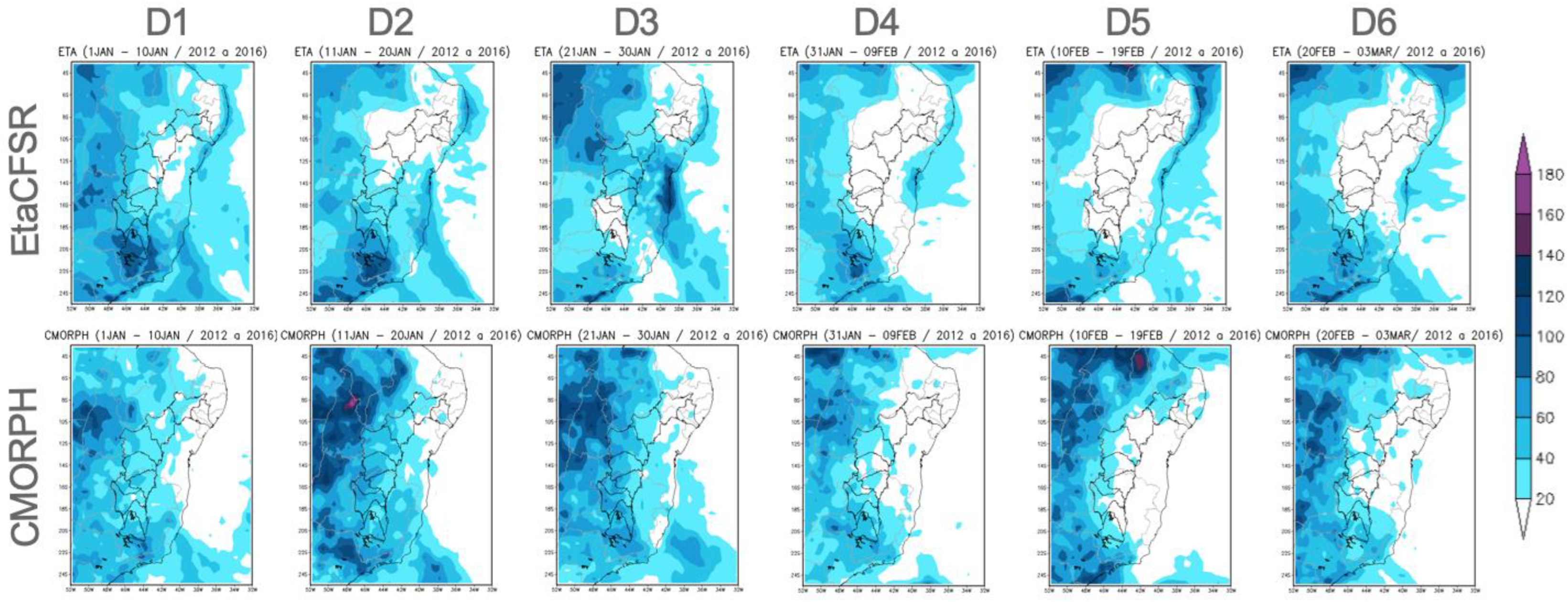
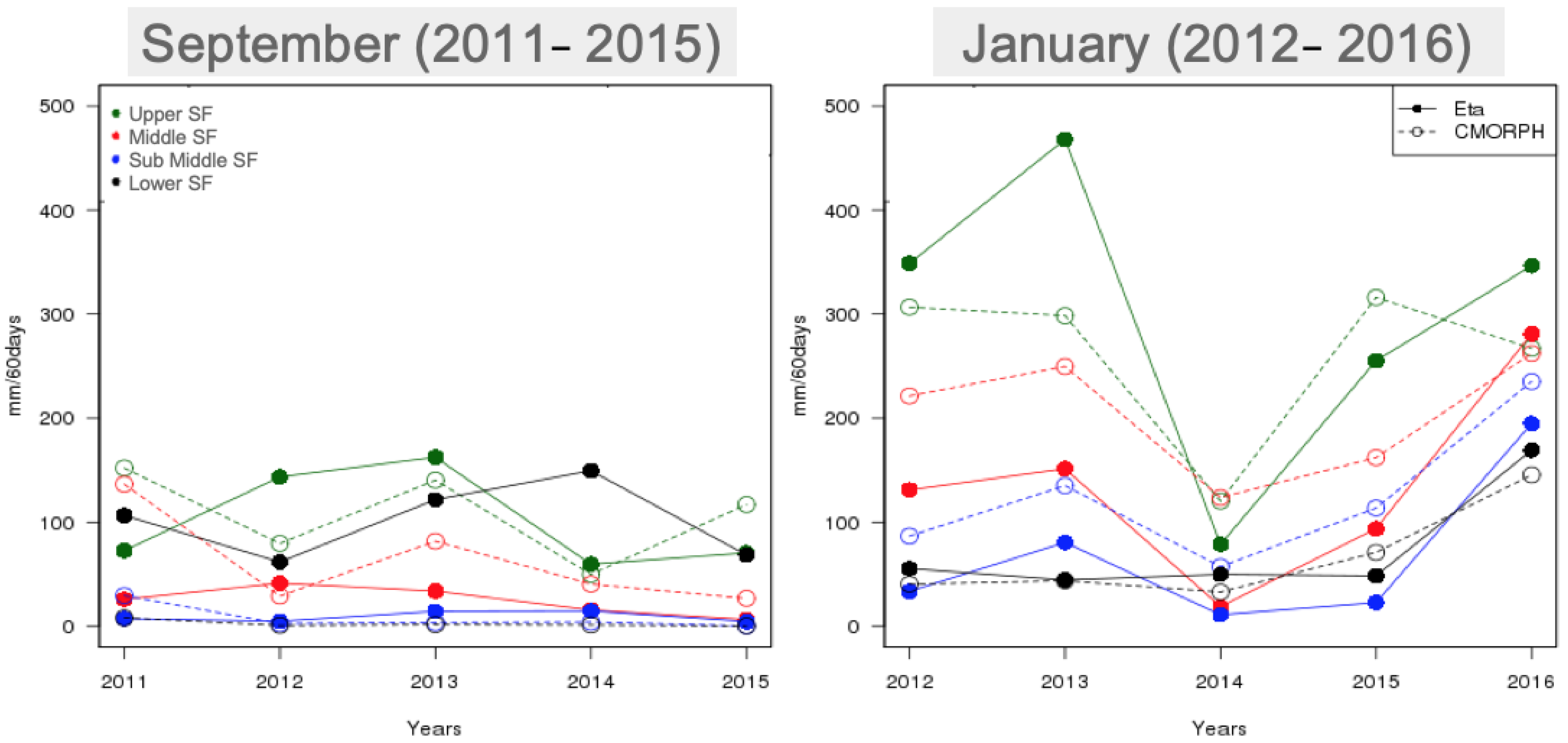
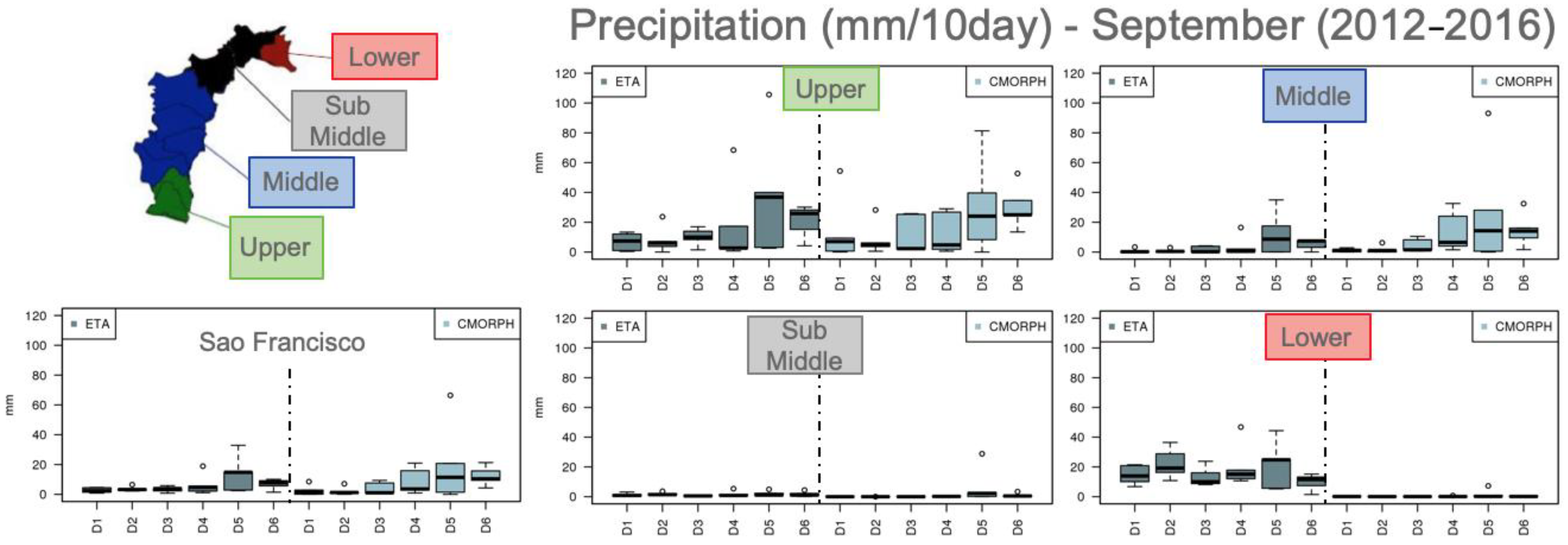
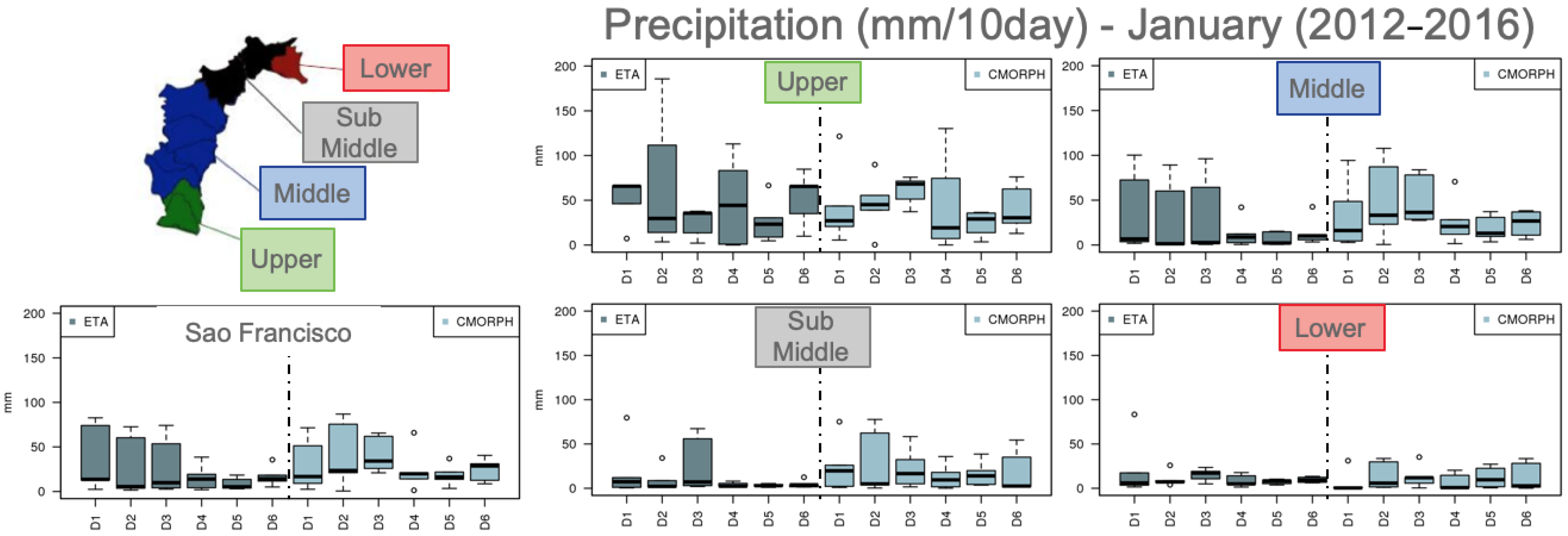
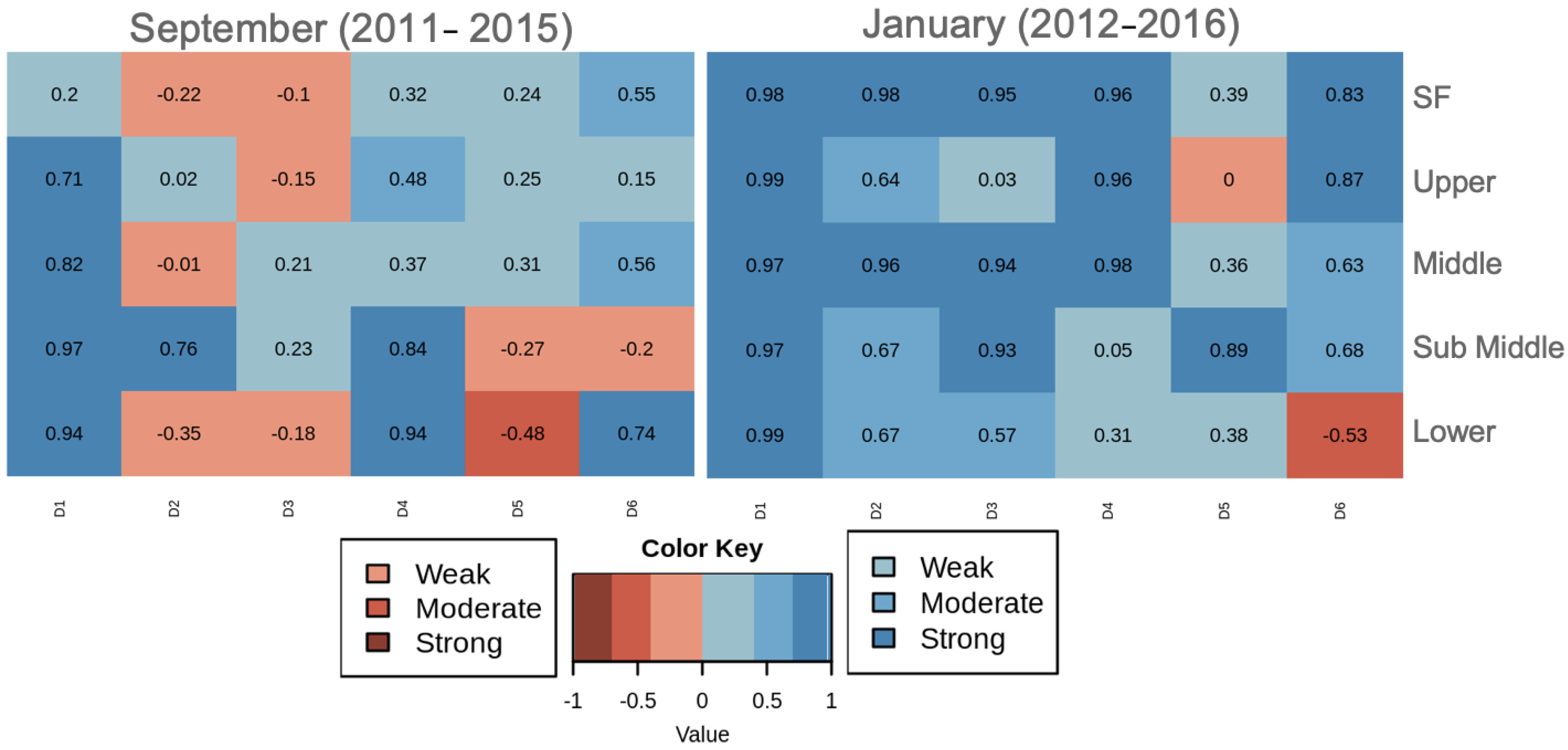
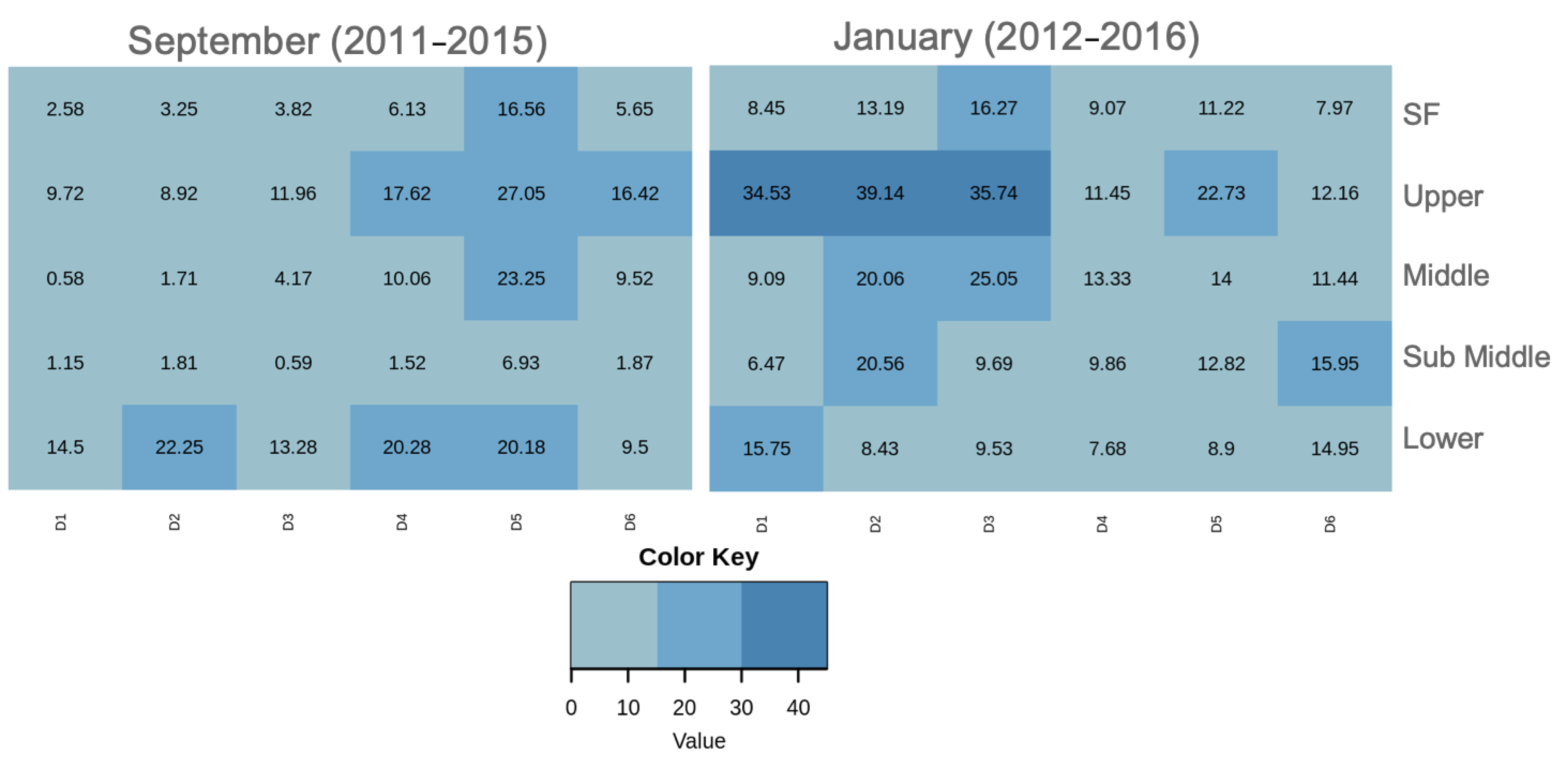
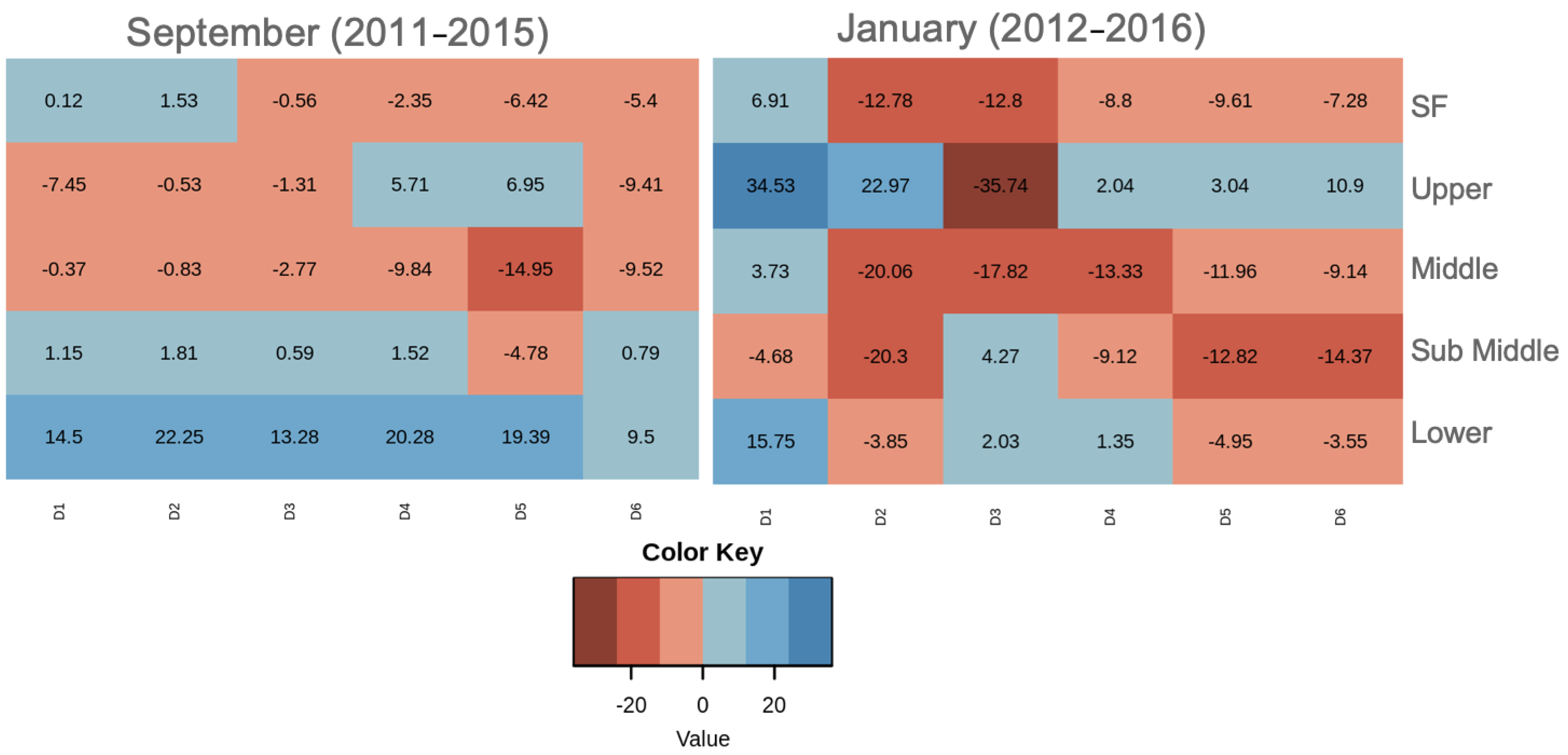
Disclaimer/Publisher’s Note: The statements, opinions and data contained in all publications are solely those of the individual author(s) and contributor(s) and not of MDPI and/or the editor(s). MDPI and/or the editor(s) disclaim responsibility for any injury to people or property resulting from any ideas, methods, instructions or products referred to in the content. |
© 2023 by the authors. Licensee MDPI, Basel, Switzerland. This article is an open access article distributed under the terms and conditions of the Creative Commons Attribution (CC BY) license (https://creativecommons.org/licenses/by/4.0/).
Share and Cite
Ferreira, N.C.R.; Chou, S.C.; Dereczynski, C. Evaluation of Subseasonal Precipitation Simulations for the Sao Francisco River Basin, Brazil. Climate 2023, 11, 213. https://doi.org/10.3390/cli11110213
Ferreira NCR, Chou SC, Dereczynski C. Evaluation of Subseasonal Precipitation Simulations for the Sao Francisco River Basin, Brazil. Climate. 2023; 11(11):213. https://doi.org/10.3390/cli11110213
Chicago/Turabian StyleFerreira, Nicole C. R., Sin C. Chou, and Claudine Dereczynski. 2023. "Evaluation of Subseasonal Precipitation Simulations for the Sao Francisco River Basin, Brazil" Climate 11, no. 11: 213. https://doi.org/10.3390/cli11110213
APA StyleFerreira, N. C. R., Chou, S. C., & Dereczynski, C. (2023). Evaluation of Subseasonal Precipitation Simulations for the Sao Francisco River Basin, Brazil. Climate, 11(11), 213. https://doi.org/10.3390/cli11110213






